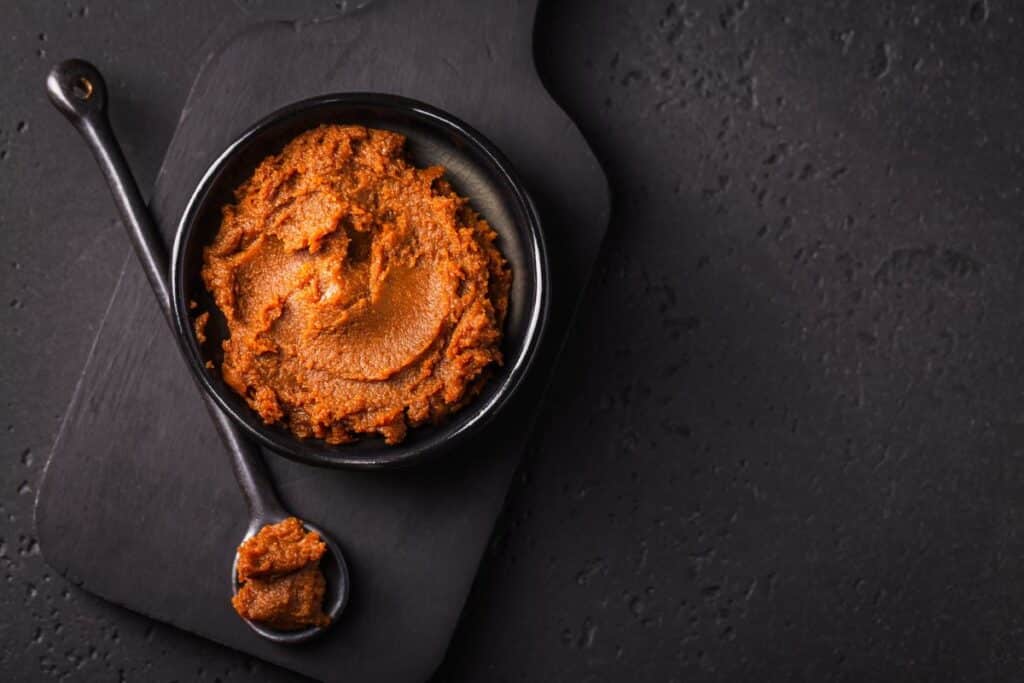Quick summary: Soy sauce, shoyu, tamari, aminos, fish sauce, and more can be perfect miso substitutes for your Japanese dishes. Pay attention to the needed quantity since many replacements taste milder than the original miso.
Miso, a traditional Japanese seasoning, has gained popularity worldwide for adding depth, rich umami flavor, and saltiness to a variety of dishes.
Miso soup is a well-known dish where the ingredient is used, but it is also included in a host of other recipes such as fish, meat, vegetables, sauces, and pickling.
If you are trying your hand at Japanese cooking for the first time, it is very likely that your recipe will require this staple ingredient.
Don’t worry if you don’t have any at home, there are multiple easy substitutes you can use instead. If you, or someone you are cooking for, have a soy allergy, choose a soy-free miso alternative from the list below.
Here’s what you need to know when choosing the best miso paste substitute for a hearty, savory meal.
What Is Miso?
Miso is a paste made from soybeans, fermented with salt and kōji, an edible fungus. It comes in many different types with some varieties, including grains such as rice, rye, or barley in the production process. The most popular types of miso are red miso, white miso, and mixed miso.
Red miso paste is aged for long periods, and the color can vary from red to deep brown depending on the soybean preparation, quantity of soybeans, and fermentation time. It is very salty with a strong, pungent taste.
White miso only contains a small amount of soybeans, with the main ingredients being rice and/or barley. It has a shorter fermentation time with a softer umami flavor and a hint of sweetness.
Read more on miso paste shelf life and whether it can go bad.
How Is Miso Paste Used?
Besides being a staple flavoring in many Japanese recipes, miso also adds a unique flavor to marinades, ramen dishes, gravy, and tofu. In less traditional ways, it can be used to make miso butter, enhance a panko crust, to flavor soups and stews, stir fry sauces, and whisked into salad dressing.
Due to its bold taste, it is generally only used in small amounts.
Keep in mind that white miso is not quite as salty as the red variety. Thus, when using a substitute for white miso paste, add slightly less to start with to avoid overwhelming your dish with saltiness.
Best Miso Paste Substitutes
# 1. Soy Sauce
Since soy sauce is also made from fermented soybeans, this is undoubtedly our number one pick to use as a substitute. Similarly, it has a rich, salty umami taste.
It is a Chinese staple used in everything from marinades and sauces to meat and vegetable dishes, dumplings, broths, soups, and stir fry. You can also use it as a replacement in stews, rice dishes, dipping sauces, and egg dishes.
The sauce has a dark color and is liquid as opposed to being in a paste form. This means it can slightly change the consistency of your recipe, depending on what you are cooking up. It is, therefore, best used in liquid-based dishes.
If you are allergic to soy and gluten or need to reduce the amount of salt in your diet, this is not a good substitute. You can, however, look for specialty varieties that come in low-sodium and gluten-free types.
Substitute Quantity: Depending on the type of miso you are replacing, you can use a 1:1 ratio. Since it’s hard to balance out something that is overly salty once the damage is done, we recommend rather starting with half the amount called for in your recipe and adding more to taste.
Soy sauce is not that spoilable food, but pay attention to possible quality loss. Here’s all you must know about how long soy sauce can last.
# 2. Shoyu Sauce
Shoyu sauce is the Japanese version of soy sauce. It’s made in very much the same way and is popularly used with sushi and dumplings.
This is another staple in Japanese cuisine which makes it a perfect substitute. As with soy sauce, it is a liquid and not a paste which may influence the consistency of your dish. It also has a high salt content and contains wheat, so consider this if these factors are a concern in your diet.
Substitute Quantity: Since shoyu is slightly less salty than soy sauce, you can use it as a substitute in equal quantities.
# 3. Tamari
Similar to both the above substitutes, tamari is made with fermented soybeans; however, it does not contain wheat.
This makes it a good substitute for people with wheat allergies. Always check the label to be sure it is gluten-free, as some brands may contain a trace amount of gluten.
It’s salty and slightly thicker than shoyu, but still not nearly as thick as miso. Therefore, you can use it in the same way as you would the above two options.
Substitute Quantity: Replace tamari in equal amounts.
# 4. Coconut Aminos
Coconut aminos is the soy-free, lower-salt version of soy sauce. It is made from fermented coconut juices but does not have a coconutty flavor. It is a great substitute for white miso since it has a slightly sweet undertone and is not as overly salty as the above options.
It’s also free of yeast and gluten (always check the label). Coconut aminos will add a great depth of flavor and umami notes to liquid-based dishes and dipping sauces. It is usually available from well-stocked supermarkets or health food stores.
Substitute Quantity: Start with ¼ to half the amount your recipe calls for and add to taste. Add a small pinch of salt if you feel it is lacking the salty punch you need.
# 5. Liquid Aminos
Liquid aminos is also a soybean product, however, this sauce is not fermented. It’s gluten-free and has a salty but slightly milder taste and a touch of sweetness.
Substitute Quantity: Start with ¼ to half the amount your recipe calls for and add to taste.
# 6. Fish Sauce
Fish sauce is a staple in Vietnamese, Thai, and Chinese cuisine. It has a light, clear color and thin consistency, which may affect the consistency of your dish. It is suitable to use in dipping sauces, soups, stews, marinades, dressings, rice dishes, curry, and stir fry.
Fish sauce is produced from salted and fermented fish or krill, which gives it a strong aroma. The taste, however, is not quite as fishy as the smell. It adds great umami and savory flavor to dishes.
Since it packs quite a punch, it needs to be used in small quantities to get the best benefits.
If you have a seafood allergy or you are vegan, choose another option instead.
Substitute Quantity: Start with ¼ of the amount your recipe calls for. Mix it in well and add to taste in small amounts if necessary.
Fish sauce is more likely to spoil after opening, not before. Here’s guidance on possible deterioration signs and fish sauce shelf life.
# 7. Dashi
This Japanese-style broth is not something you likely have in your pantry unless you cook a lot of Asian cuisines. Dashi forms the base of miso soup and will add similar flavor notes and a wonderful depth of flavor to your dish.
It is often made from cold-brewed kombu; however, there are different versions made from dried shrimp, mushrooms, scallops, or toasted soybeans.
Substitute Quantity: Since dashi is a broth, it will affect the consistency of your dish. If you are making soup, stew, or sauce, replace some of the liquid in your dish with dashi. If you only need a small amount, you can use it as a replacement in equal measures.
# 8. Anchovy Paste
Finally, a miso substitute that is also in a paste form to give you the same thick consistency! Anchovy paste has a strong, punchy and salty flavor.
As its name suggests, it is made from pureed anchovies. Used in small quantities, it can add a wonderful umami depth and savoriness to dishes that need bold flavor.
Using a little too much will quickly overpower delicate flavors, so use with caution and always taste before adding more.
Although the flavor profile is not exactly the same, it is a good option in dishes that will be cooked, such as marinades, curry, stews, and sauces. It is ideal for recipes where the thick paste consistency is important.
Substitute Quantity: Start by using half of what your recipe calls for.
# 9. Vegetable Broth
Vegetable broth comes in varying strengths and flavors, but mostly you can be assured that it will add a depth of flavor to your stew or soup, and as a bonus, it is vegan-friendly.
Similar to dashi, this lightly flavored liquid alternative should replace the liquid in your recipe as opposed to just a tablespoon or teaspoon of miso.
Vegetable broth is made by simmering onions, carrots, celery, and garlic. The cooked vegetables are then strained, leaving the flavorful broth. Mushrooms, vegetables, fresh herbs, dried herbs, and seasonings can also be included.
You can make your own vegetable broth by simmering your leftover vegetable scraps. Saute the veggies and vegetable cut-offs in a pot. Add water and seasonings, then let it simmer for a couple of hours.
Once the liquid is cooked to the desired flavor intensity, strain it through cheesecloth to obtain a clear broth.
Broth can be frozen, so make large batches and freeze them so you always have some on hand.
# 10. Maggi Seasoning
Maggi sauce has a similar flavor to the yeast condiment, Vegemite. The sauce is made from fermented wheat proteins and is very salty with loads of umami flavor.
Substitute Quantity: Start by using ¼ of the amount your recipe calls for and add more to taste.
FAQ
Miso is best stored refrigerated after opening. Make sure it is kept covered in an airtight container.
If stored properly, it will last up to a year since it has a high salt content which acts as a preservative.
Teriyaki sauce is much sweeter and will not make a good substitute. If your recipe also calls for sugar or honey and ginger as part of the ingredients, you can use teriyaki as a combination substitute for all the seasonings, although the flavor might not be an identical match.
Conclusion
Even in small quantities, miso packs a big salty, umami flavor punch. If you need a substitute, there are many options to choose from.
Most miso substitutes are thinner in consistency. This means you might have to make some slight adjustments to the liquid ratios in your recipe.
If you are unfamiliar with any of the ingredients you are using, always err on the side of caution and initially add less than your recipe calls for. Once well combined with the other ingredients, taste the mixture and then add more if needed.
*image by brebca/depositphotos









